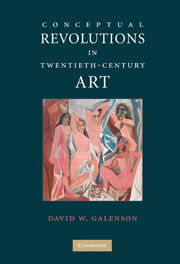Book contents
- Frontmatter
- Contents
- List of Tables
- Preface
- Introduction: And Now for Something Completely Different
- 1 The Back Story of Twentieth-Century Art
- 2 The Greatest Artists of the Twentieth Century
- 3 The Most Important Works of Art of the Twentieth Century
- 4 The Greatest Artistic Breakthroughs of the Twentieth Century
- 5 The Greatest Women Artists of the Twentieth Century
- 6 Creating New Genres: Conceptual Artists at Work and Play in the Twentieth Century
- 7 And Now for Something Completely Different: The Versatility of Conceptual Innovators
- 8 You Cannot Be Serious: The Conceptual Innovator as Trickster
- 9 Painting by Proxy: The Conceptual Artist as Manufacturer
- 10 Co-Authoring Advanced Art
- 11 Language in Visual Art
- 12 Portraits of the Artist: Personal Visual Art in the Twentieth Century
- 13 The Rise and (Partial) Fall of Abstract Painting in the Twentieth Century
- 14 The Globalization of Advanced Art in the Twentieth Century
- 15 Artists and the Market: From Leonardo and Titian to Warhol and Hirst
- 16 The State of Advanced Art: The Late Twentieth Century and Beyond
- Notes
- Bibliography
- Index
6 - Creating New Genres: Conceptual Artists at Work and Play in the Twentieth Century
Published online by Cambridge University Press: 05 June 2012
- Frontmatter
- Contents
- List of Tables
- Preface
- Introduction: And Now for Something Completely Different
- 1 The Back Story of Twentieth-Century Art
- 2 The Greatest Artists of the Twentieth Century
- 3 The Most Important Works of Art of the Twentieth Century
- 4 The Greatest Artistic Breakthroughs of the Twentieth Century
- 5 The Greatest Women Artists of the Twentieth Century
- 6 Creating New Genres: Conceptual Artists at Work and Play in the Twentieth Century
- 7 And Now for Something Completely Different: The Versatility of Conceptual Innovators
- 8 You Cannot Be Serious: The Conceptual Innovator as Trickster
- 9 Painting by Proxy: The Conceptual Artist as Manufacturer
- 10 Co-Authoring Advanced Art
- 11 Language in Visual Art
- 12 Portraits of the Artist: Personal Visual Art in the Twentieth Century
- 13 The Rise and (Partial) Fall of Abstract Painting in the Twentieth Century
- 14 The Globalization of Advanced Art in the Twentieth Century
- 15 Artists and the Market: From Leonardo and Titian to Warhol and Hirst
- 16 The State of Advanced Art: The Late Twentieth Century and Beyond
- Notes
- Bibliography
- Index
Summary
Introduction
What is sculpture? What is painting? Everyone's still clinging to outdated ideas, obsolete definitions, as if the artist's role was not precisely to offer new ones.
Pablo PicassoThe twentieth century was a time of extremely rapid and sustained artistic innovation. One striking feature of this is the increase in the number of kinds of art that occurred during the century. Even casual observers of the art world are aware that some of the most popular forms among contemporary artists, including video and installation, are of recent vintage. Yet although all narratives of the art of the past century discuss many new art forms, none has systematically surveyed these innovations. Doing so shows that dozens of new genres of art were invented during the twentieth century, and reveals some surprisingly strong general characteristics that unite what have usually been considered as widely disparate artistic forms, lacking any overall coherence or commonality. Overall, this survey clarifies our understanding of how and why the art of the twentieth century stands apart from earlier art.
Format
This chapter will present a chronological narrative of forty-nine artistic genres that were invented during the twentieth century. These vary considerably in importance: some are widely used today, while others are rare or extinct. Of the forty-nine genres, twenty-two are contained as entries in the Oxford English Dictionary. Each of these, when first mentioned, will be footnoted to its OED entry; unless noted otherwise, these references will be to the second edition, as reprinted in 1991.
- Type
- Chapter
- Information
- Conceptual Revolutions in Twentieth-Century Art , pp. 112 - 134Publisher: Cambridge University PressPrint publication year: 2009

